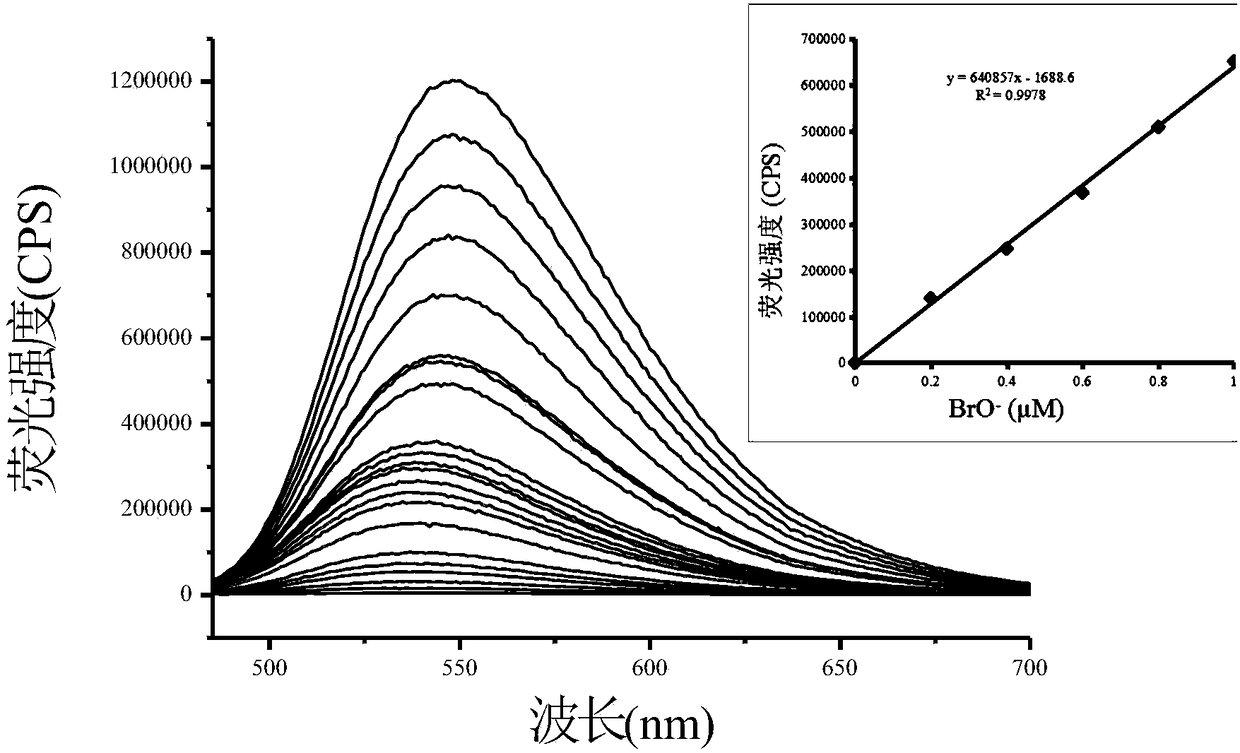Quick, highly selective and ultra-sensitive hypobromous acid fluorescence probe
A technology of sulfonic acid groups and compounds, applied in fluorescence/phosphorescence, luminescent materials, and material analysis through optical means, can solve the problems of insufficient response speed, insufficient selectivity, and insufficient sensitivity, and achieve rapid reaction and synthesis Simple and stable effect
- Summary
- Abstract
- Description
- Claims
- Application Information
AI Technical Summary
Problems solved by technology
Method used
Image
Examples
Embodiment 1
[0034]
[0035]
[0036] (Scheme 1) Dissolve 232mg (1mmol) of 4-chloro-1,8-naphthalene anhydride in 15mL of ethanol, then add 130mg (1mmol) of 2-aminoethylmorpholine, then stir and react at 85°C for 6h, after the reaction Ethanol was evaporated to dryness to obtain the crude product. Finally, a mixed system of dichloromethane and methanol (75:1, v / v) was used for column chromatography to obtain 235.3 mg of a white pure product with a yield of 65%.
[0037] Dissolve 344 mg (1 mmol) of the fluorophore compound in 15 mL of ethylene glycol methyl ether, then add 183.24 mg (3 mmol) of monoethanolamine, then stir and react at 140°C for 12 hours, and spin evaporate to dryness of ethylene glycol methyl ether after the reaction is complete to obtain crude product. Finally, a mixed system of dichloromethane and methanol (50:1, v / v) was used for column chromatography to obtain 305.8 mg of a yellow pure product with a yield of 58%.
[0038] (Scheme 2) Dissolve 232mg (1mmol) of 4-c...
Embodiment 2
[0046] figure 1 It is the change graph of the fluorescence spectrum of the hypobromous acid fluorescent probe (5 μM) after adding hypobromous acid (0-10 μM). It can be clearly seen from the figure that with the increase of the concentration of hypobromous acid added, the fluorescence intensity at 550 nm of the solution gradually decreases. Moreover, it can be seen from the illustration that the change of the fluorescence intensity at 550 nm has a good linear relationship with the concentration of the added hypobromous acid, which proves that the fluorescent probe can be used for quantitative analysis of hypobromous acid.
Embodiment 3
[0048] figure 2 It is the graph showing the change of fluorescence spectrum with time after adding hypobromous acid fluorescent probe (5 μM) to hypobromous acid (5 μM). It can be clearly seen from the figure that when hypobromous acid is added, the detected fluorescence intensity is instantly quenched and reaches the plateau, which shows that the probe reacts rapidly with hypobromous acid and can provide a rapid analysis method for the determination of hypobromous acid.
PUM
 Login to View More
Login to View More Abstract
Description
Claims
Application Information
 Login to View More
Login to View More - R&D
- Intellectual Property
- Life Sciences
- Materials
- Tech Scout
- Unparalleled Data Quality
- Higher Quality Content
- 60% Fewer Hallucinations
Browse by: Latest US Patents, China's latest patents, Technical Efficacy Thesaurus, Application Domain, Technology Topic, Popular Technical Reports.
© 2025 PatSnap. All rights reserved.Legal|Privacy policy|Modern Slavery Act Transparency Statement|Sitemap|About US| Contact US: help@patsnap.com



